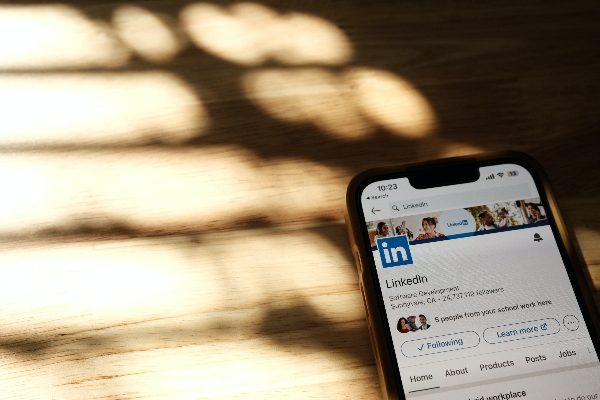Be found on Linkedin
Along with a well written and presented CV, your Linkedin profile is arguably of equal importance when it comes to making a good impression on an prospective employer. Certainly if you don’t already have a Linkedin profile then we would recommend you set one up. It’s free to do and easy to get started with this step-by-step tutorial;
Even for those who regularly update their profiles, there are a few additional pointers here to ensure that your profile ‘pops’ and you will be found on Linkedin by Recruiters and employers alike!
OUR 10 TIPS FOR OPTIMISING YOUR LINKEDIN PROFILE
Step 1: Your profile picture and banner image
Don’t underestimate the power of a good image on your profile. Just like in an in-person meeting, your images are the first thing that a viewer will see when they click on your profile, and a good photo and banner image can help to give your profile that professional edge. With regards to the photo, we would recommend that you choose a recent image (within last few years), that shows your full face & shoulders, ideally on a plain or white backdrop. Avoid blurry or obscured images that will make it difficult to identify you.
For your banner image, we would recommend sourcing a photo or image that has something to do with your choice of career. It could be colourful, striking or relatively plain but most importantly it will be obvious to the viewer ‘what you do’. Use a free design tool such as Canva to crop an image to avoid it looking squashed or pixelated.
Step 2: Does your profile clearly identify your career and profession?
After your name, add a comma and type out what you do. For example:
“HR recruitment expert”
“Expert Leadership Coach”
Often, your name is the only thing people will read so use this opportunity to tell them exactly what you do!
Step 3: The Headline
Use your headline to summarise what you do and what skills and experience you have to offer. Put yourself in your viewers’ shoes; after reading your Headline, they should know immediately what you do for a job and therefore be able to quickly identify whether your profile would be relevant for their vacancy.
Quick Tip: LinkedIn has a restriction on headline character counts. Update your headline on the LinkedIn mobile app (rather than on linkedin.com) and you’ll be able to add in a longer headline!
Step 4: Location
Check it’s correct – Recruiters often search by location or postcode, so make sure you’ve added the correct location here.
Step 5: About
Add an About section to your profile:
Use your About section to again detail your specialist skills and experience. Perhaps here, you could lift a few points from your CV profile, or add a few bullet points to showcase your expertise, qualifications and/or experience.
Include a call to action to encourage people to get in touch.
Stay away from jargon and boring stuff.
Again, put yourself in your ideal employers’ shoes. What do THEY need to hear to make them decide it’s worth their while to reach out to you?
A few points to remember:
Use short paragraphs – many people will only skim your summary so don’t overwhelm them with long chunky paragraphs.
Keep it short and sweet – no one wants to read an essay. Just provide enough information to be clear.
Step 6: Featured
Add a Featured section to your profile. To do this click the + button in the Featured section to add links to your employer’s website, or showcase a portfolio or business by uploading a presentation:
You can use this function to add additional content that will further enhance your profile.
Step 7: A personalised Linkedin URL
Create a personalised URL for your profile by clicking “edit public profile & URL” in the top right corner of your profile. In the new tab that opens, hit the ‘edit’ pen symbol to personalise your URL. It’s good practice to use your name and / or profession in your personalised URL.
Step 8: Experience
This section should broadly match with your CV, although please avoid adding all of the content from your CV! Simply add each job role, ensuring that the employment dates match those on your CV. Then add a few bullet points or brief paragraphs, to describe your duties and responsibilities.
Step 9: Education & Voluntary work
You can add your education and qualifications to this section to showcase your schooling, university degree and / or any professional qualifications. It’s a good idea to make sure that you add any further qualifications that you may have picked up along the way, that are relevant to your profession or future career choice.
Step 10: Get Recommended!
Linkedin allows you to give and receive recommendations of friends, colleagues, managers and customers using this feature. It really is great practice to ask a few people to endorse you on Linkedin, as nothing adds more gravitas to a profile than a recent recommendation from a former manager or even from a client. You can add as many as you like, but remember it’s only fair to give as well as receive, so perhaps offer to exchange recommendations!
Other Tips to be found on Linkedin:
Refine the other information on your profile to support your position as an expert in your industry.
Remove information that does not support this. For example, unless you work in hospitality there’s no need to mention that bar job you had at university on your profile.
To conclude
We hope that you find these tips useful and that your profile now be found on Linkedin by prospective employers. If you would like to listen to a few additional tips from our recruitment team, then please click here to watch a brief video on the subject.



